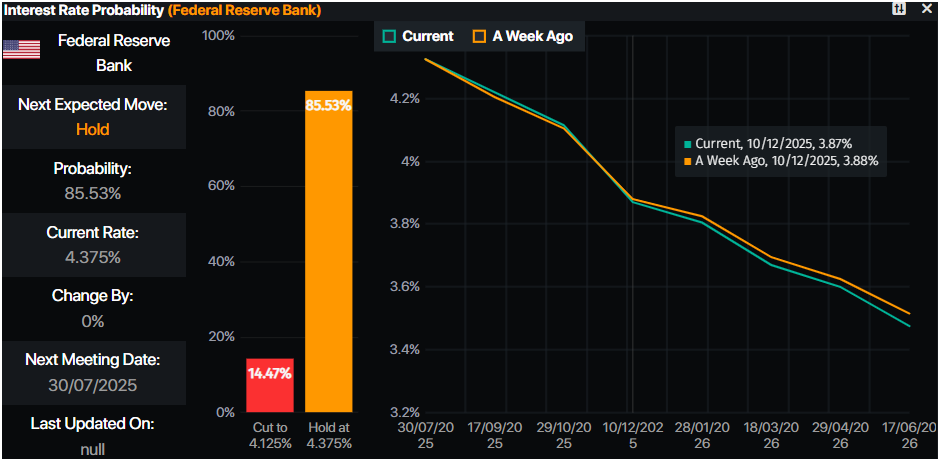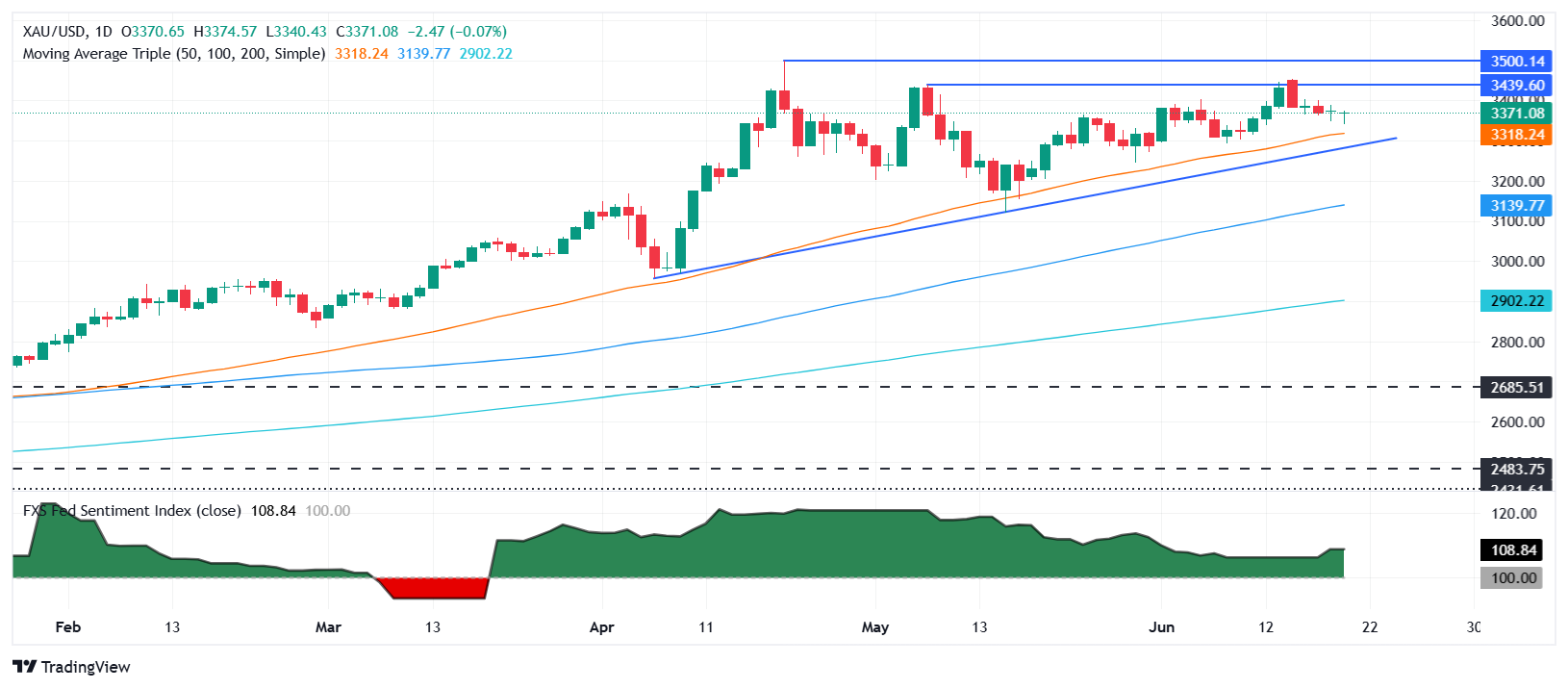Gold holds steady as Trump delays Iran strike; weekly loss nears 1.9%
- Gold trades flat near $3,369, on track for a weekly loss of nearly 1.90%.
- Trump backs off immediate Iran action, boosting risk sentiment and denting safe-haven demand.
- Fed officials split on rate outlook; Waller eyes July cut, Barkin stays cautious.
Gold price trades flat on Friday and is poised to end the week with a nearly 1.90% loss, after US President Donald Trump delayed taking military action against Iran, opting instead for a diplomatic solution. At the time of writing, XAU/USD trades at $3,369, down 0.11%.
Sentiment turned sour outside of geopolitical events, related to “US may revoke waivers for allies with semiconductor plants in China,” as Bloomberg reported. Trump’s decision on Iran boosted risk appetite, a headwind for Gold prices.
Meanwhile, Israel and Iran continued to exchange blows. Reuters reported that an Iranian senior official stated they’re ready to discuss limitations on uranium enrichment. However, they said “zero enrichment will undoubtedly be rejected by Tehran, especially now, under Israel's strikes.”
In the meantime, Federal Reserve (Fed) officials began to cross the wires after the central bank decided to hold rates unchanged, adopting a slightly hawkish stance. Fed Governor Christopher Waller turned uber dovish, eyeing the first rate cut at the July meeting.
In opposition to him, the Fed revealed its Monetary Policy Report, in which it mentioned that policy “is well positioned for what lies ahead,” amid geopolitical and tariff uncertainty. Alongside this, Richmond Fed President Thomas Barkin said he is in no rush to cut rates.
Although Gold has dipped this week, it is typically sought during periods of geopolitical tensions and lower interest rates However,the Fed’s restrictive tilt may prompt investors to turn toward other currencies alongside the US Dollar.
Next week, the US economic docket will feature Fed speeches, S&P Global Flash PMIs, housing and inflation data, alongside Gross Domestic Product (GDP) figures.
Daily digest market movers: Gold stays firm, hoovering near $3,370 on risk-off mood
- The US 10-year Treasury note yield is flat at 4.391%. US real yields, which are inversely correlated with Gold prices, are also unchanged at 2.081%.
- The US Dollar Index (DXY), which tracks the US Dollar’s value against six currencies, is poised to end the week with a 0.50% gain, at 98.65.
- Data in the United States (US) revealed that the economy is slowing down, as indicated by the latest Philadelphia Fed Manufacturing Index in June, which dropped to -4, unchanged from May but worse than the estimated -1 contraction.
- The Fed's Monetary Policy Report recently revealed that there are early signs that tariffs are contributing to higher inflation. However, their full impact has yet to be reflected in the data. The report added that the current policy is well-positioned and that financial stability is resilient amid high uncertainty.
- Fed Chair Powell commented that the effects of tariffs will depend on the level, adding that “Increases this year will likely weigh on economic activity and push up inflation.” Powell said that “As long as we have the kind of labor market we have and inflation coming down, the right thing to do is hold rates.”
- Money markets suggest that traders are pricing in 46 basis points of easing toward the end of the year, according to Prime Market Terminal data.

Source: Prime Market Terminal
XAU/USD technical outlook: Gold price to remain pressured below $3,400
Gold price uptrend remains intact, but as of writing, it has dipped below $3,375. On its way down, XAU/USD hit a five-day low of $3,340 before bouncing off those lows as buyers lifted the spot price.
The Relative Strength Index (RSI) is bullish, despite turning flat. That said, further sideways action is likely in the near term.
For a bullish resumption, XAU/USD must clear $3,400. Once hurdled, the following key resistance levels, such as the $3,450 mark and the record high of $3,500, lie ahead. Otherwise, if Bullion drops below $3,370, the pullback could extend toward the $3,350 mark and to the 50-day Simple Moving Average (SMA) at $3,308. Further losses are seen once cleared, at the April 3 high-turned-support at $3,167.

Gold FAQs
Gold has played a key role in human’s history as it has been widely used as a store of value and medium of exchange. Currently, apart from its shine and usage for jewelry, the precious metal is widely seen as a safe-haven asset, meaning that it is considered a good investment during turbulent times. Gold is also widely seen as a hedge against inflation and against depreciating currencies as it doesn’t rely on any specific issuer or government.
Central banks are the biggest Gold holders. In their aim to support their currencies in turbulent times, central banks tend to diversify their reserves and buy Gold to improve the perceived strength of the economy and the currency. High Gold reserves can be a source of trust for a country’s solvency. Central banks added 1,136 tonnes of Gold worth around $70 billion to their reserves in 2022, according to data from the World Gold Council. This is the highest yearly purchase since records began. Central banks from emerging economies such as China, India and Turkey are quickly increasing their Gold reserves.
Gold has an inverse correlation with the US Dollar and US Treasuries, which are both major reserve and safe-haven assets. When the Dollar depreciates, Gold tends to rise, enabling investors and central banks to diversify their assets in turbulent times. Gold is also inversely correlated with risk assets. A rally in the stock market tends to weaken Gold price, while sell-offs in riskier markets tend to favor the precious metal.
The price can move due to a wide range of factors. Geopolitical instability or fears of a deep recession can quickly make Gold price escalate due to its safe-haven status. As a yield-less asset, Gold tends to rise with lower interest rates, while higher cost of money usually weighs down on the yellow metal. Still, most moves depend on how the US Dollar (USD) behaves as the asset is priced in dollars (XAU/USD). A strong Dollar tends to keep the price of Gold controlled, whereas a weaker Dollar is likely to push Gold prices up.
